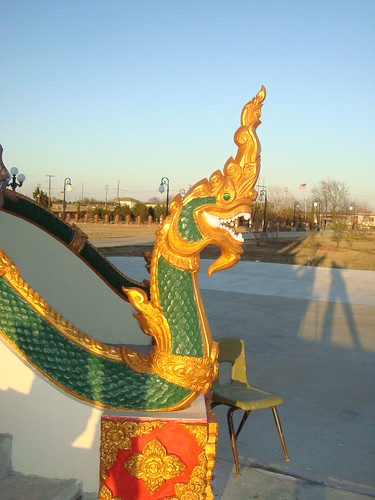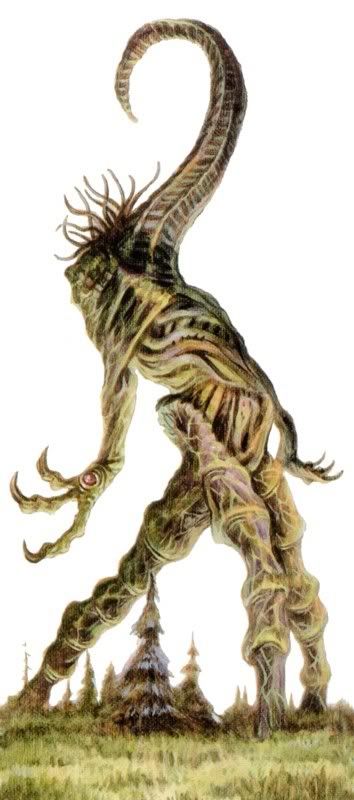Today we're considering Nyarlathotep and the Nak, and to a lesser extent, the Nyak.

Meanwhile, within the Cthulhu Mythos, there is the cosmic entity known as Nyarlathotep:

Nyarlathotep is an "Outer God" known by many names and forms, including the Crawling Chaos. First appearing in Lovecraft's 1920 prose poem of the same name, he was later mentioned in other works by Lovecraft and by other writers of the 20th and 21st century. The form above is often referred to as the Howler In The Dark.
Lovecraft initially wrote of Nyarlathotep as:
"...Nyarlathotep came out of Egypt. Who he was, none could tell, but he was of the old native blood and looked like a Pharaoh. The fellahin knelt when they saw him, yet could not say why. He said he had risen up out of the blackness of twenty-seven centuries, and that he had heard messages from places not on this planet. Into the lands of civilisation came Nyarlathotep, swarthy, slender, and sinister, always buying strange instruments of glass and metal and combining them into instruments yet stranger. He spoke much of the sciences - of electricity and psychology - and gave exhibitions of power which sent his spectators away speechless, yet which swelled his fame to exceeding magnitude. Men advised one another to see Nyarlathotep, and shuddered. And where Nyarlathotep went, rest vanished; for the small hours were rent with the screams of a nightmare."
Within the Cthulhu Mythos, the Outer Gods and Great Olds Ones are mindless entities of terror, not so much malevolent but indifferent to humanity. Nyarlathotep is distinguished from these because it is often considered cruel, deceptive and manipulative. Its role within this cosmology is to enact the will of the Outer Gods, serving as their messenger. It is more interested in causing madness over destruction, and is written of as an apocalyptic entity who will most likely be responsible for destroying the human race and the Earth.
In the mythos literature to date, Nyarlathotep has appeared in Asia in numerous forms. In China, it can arrive as "The Bloated Woman." This form initially appears as a slender maiden behind a fan, but this fan is casting an illusion masking the true form of a large bloated tentacled humanoid that devours brains. In Malaysia, it has appeared as Shugoran, a black humanoid creature playing a horn who is summoned to punish others. It has also been known as "The Dweller in Darkness," "The Faceless God," "The Floating Horror," and "The Thing in the Yellow Mask." So what is one of its likely aspects in Laos?
As a shapeshifting entity, it would most likely appear as an iteration of a giant Nyak, similar to the Rakshasas of India and the Ramakien, magical, man-eating 'ogres'. The Nyak are feared for disturbing sacrifices, desecration of graves, harassing holy men and women, possession of human beings, and most other things we might expect of evil beings. I should note the Nyak are not always evil, and many took vows to protect the Dharma, the teachings of the Buddha in the White Lotus Sutra. The fingernails of a Nyak are often poisonous and their favorite food is human flesh and rotten food. In addition to being shapechangers and warriors, they are often illusionists and magicians.So this would be very consistent with an avatar of Nyarlathotep. In the Lao language might we see him referred to as Nyak Dam, The Black Nyak?
On the other hand, the Nak are not entities a Lao writer would present as villainous, because they are historically protectors of the Lao. (Of course, nearby mythologies take a different view of the Nak/Naga due to politics, etc. but that's not necessarily germaine to this discussion.) However, if we were to postulate how Nyarlathotep appears, it might come as Nak Dam, the Black Nak, which would be a blasphemous parody of the traditional form of the Nak.
If we were keeping consistent with prior appearances, Nak Dam would most likely appear with a tri-lobed eye, black scales, and numerous tentacles protruding from a number of obscene, terrifying heads. Based on Lovecraft's poem, we can speculate Nyarlathotep's aspect of Nak Dam would do similar things it does in Europe and America: Wandering the earth, gathering devotees by demonstrating strange, almost magical technology that eventually causes them to lose awareness of the world, of the passage of time, eventually leading to insanity and plunging the world into madness.
A protagonist in Laos or who is part of a Lao expatriate community might possibly try to fight Nak Dam by turning to the dham: the truths and lessons of the Buddha, and Lao customs to retain their sense of sanity. But would they succeed?
In such a story, would a Lao reader be terrified by the possibility that Lao culture and the lessons of the Buddha be irrelevant in the face of the powers of Nyarlathotep and these cosmic entities? How else might Nyarlathotep appear, in order to strike fear in the Lao? How might these themes be meaningfully explored?
The Lao, like many communities in Southeast Asia, are only recently becoming familiar with Western notions of psychology and sanity. This leads to an interesting discussion of how Lovecraft's recurring themes of the cosmic threats to sanity and an ordered, consistent sense of the cosmos may be an utterly alien topic of terror. One can almost imagine a Lao reader going "Ha ha ha. Oh. You lost the American version of your mind? That's it?"
So what do you tap in to that evokes an interesting sense of horror from a Lao perspective?
When you have a culture that lived through the American bombing that left 30% of the countryside covered in nearly 80 million cluster bombs, Agent Orange, and so many dead, maimed and displaced by almost half a century of conflict, what's scary anymore?
Lovecraft initially wrote of Nyarlathotep as:
"...Nyarlathotep came out of Egypt. Who he was, none could tell, but he was of the old native blood and looked like a Pharaoh. The fellahin knelt when they saw him, yet could not say why. He said he had risen up out of the blackness of twenty-seven centuries, and that he had heard messages from places not on this planet. Into the lands of civilisation came Nyarlathotep, swarthy, slender, and sinister, always buying strange instruments of glass and metal and combining them into instruments yet stranger. He spoke much of the sciences - of electricity and psychology - and gave exhibitions of power which sent his spectators away speechless, yet which swelled his fame to exceeding magnitude. Men advised one another to see Nyarlathotep, and shuddered. And where Nyarlathotep went, rest vanished; for the small hours were rent with the screams of a nightmare."
Within the Cthulhu Mythos, the Outer Gods and Great Olds Ones are mindless entities of terror, not so much malevolent but indifferent to humanity. Nyarlathotep is distinguished from these because it is often considered cruel, deceptive and manipulative. Its role within this cosmology is to enact the will of the Outer Gods, serving as their messenger. It is more interested in causing madness over destruction, and is written of as an apocalyptic entity who will most likely be responsible for destroying the human race and the Earth.
In the mythos literature to date, Nyarlathotep has appeared in Asia in numerous forms. In China, it can arrive as "The Bloated Woman." This form initially appears as a slender maiden behind a fan, but this fan is casting an illusion masking the true form of a large bloated tentacled humanoid that devours brains. In Malaysia, it has appeared as Shugoran, a black humanoid creature playing a horn who is summoned to punish others. It has also been known as "The Dweller in Darkness," "The Faceless God," "The Floating Horror," and "The Thing in the Yellow Mask." So what is one of its likely aspects in Laos?
As a shapeshifting entity, it would most likely appear as an iteration of a giant Nyak, similar to the Rakshasas of India and the Ramakien, magical, man-eating 'ogres'. The Nyak are feared for disturbing sacrifices, desecration of graves, harassing holy men and women, possession of human beings, and most other things we might expect of evil beings. I should note the Nyak are not always evil, and many took vows to protect the Dharma, the teachings of the Buddha in the White Lotus Sutra. The fingernails of a Nyak are often poisonous and their favorite food is human flesh and rotten food. In addition to being shapechangers and warriors, they are often illusionists and magicians.So this would be very consistent with an avatar of Nyarlathotep. In the Lao language might we see him referred to as Nyak Dam, The Black Nyak?
On the other hand, the Nak are not entities a Lao writer would present as villainous, because they are historically protectors of the Lao. (Of course, nearby mythologies take a different view of the Nak/Naga due to politics, etc. but that's not necessarily germaine to this discussion.) However, if we were to postulate how Nyarlathotep appears, it might come as Nak Dam, the Black Nak, which would be a blasphemous parody of the traditional form of the Nak.
If we were keeping consistent with prior appearances, Nak Dam would most likely appear with a tri-lobed eye, black scales, and numerous tentacles protruding from a number of obscene, terrifying heads. Based on Lovecraft's poem, we can speculate Nyarlathotep's aspect of Nak Dam would do similar things it does in Europe and America: Wandering the earth, gathering devotees by demonstrating strange, almost magical technology that eventually causes them to lose awareness of the world, of the passage of time, eventually leading to insanity and plunging the world into madness.
A protagonist in Laos or who is part of a Lao expatriate community might possibly try to fight Nak Dam by turning to the dham: the truths and lessons of the Buddha, and Lao customs to retain their sense of sanity. But would they succeed?
In such a story, would a Lao reader be terrified by the possibility that Lao culture and the lessons of the Buddha be irrelevant in the face of the powers of Nyarlathotep and these cosmic entities? How else might Nyarlathotep appear, in order to strike fear in the Lao? How might these themes be meaningfully explored?
The Lao, like many communities in Southeast Asia, are only recently becoming familiar with Western notions of psychology and sanity. This leads to an interesting discussion of how Lovecraft's recurring themes of the cosmic threats to sanity and an ordered, consistent sense of the cosmos may be an utterly alien topic of terror. One can almost imagine a Lao reader going "Ha ha ha. Oh. You lost the American version of your mind? That's it?"
So what do you tap in to that evokes an interesting sense of horror from a Lao perspective?
When you have a culture that lived through the American bombing that left 30% of the countryside covered in nearly 80 million cluster bombs, Agent Orange, and so many dead, maimed and displaced by almost half a century of conflict, what's scary anymore?
1 comment:
Very interesting article. I apologize for asking this question here, but I did not see an email address for you. My readers/viewers would be very interested in your take on this. Would you be interested in appearing on the "Lovecraft eZine" video show? Please contact me: lovecraftezine@gmail.com
Mike Davis
www.lovecraftzine.com
Post a Comment